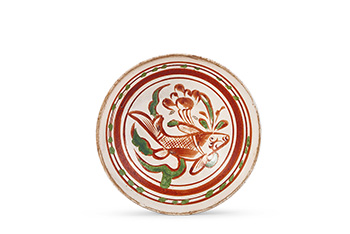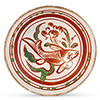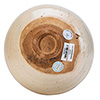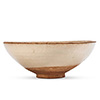LITERATURE:
The Collection of Chinese Art, Sen Shu Tey, Tokyo, 2006, p. 73, no. 101.
PROVENANCE:
Sen Shu Tey, Tokyo
Christie's, Hong Kong, The Classic Age of Chinese Ceramics - The Linyushanren Collection, Part I, 2nd December 2015, lot 2832.
EXHIBITED:
Run Through 10 Years, Sen Shu Tey, Tokyo, 2006, Catalogue, no. 101.
Catalogue Note
The bowl is painted to the interior in red and green overglaze enamels to depict a fish swimming amidst lotus. It is covered overall with a white slip under clear glaze stopping above the foot, exposing the biscuit body which is inscribed with three indecipherable characters in ink.
Cizhou polychrome decoration represents the earliest overglaze enameling in Chinese ceramic history. This technique entails two firings. On pieces like the present bowl, a milky-white slip was applied to the clay body and a colorless transparent glaze was applied to the surface of the fired glaze and the vessel was fired a second time at a lower temperature. The Chinese term of Cizhou polychrome wares, honglv cai, (red and green colors) is derived from the most popular overglaze colors in the Cizhou Palette, green and red.
Popular decorative themes on Cizhou polychrome bowls include floral patterns and aquatic scenes. A similar “fish” bowl in the collection of Sekido Museum of Art, classified as an Important Art of Object, is illustrated in Asahi Shimbun, Song Ceramics, Tokyo, 1999, p. 147, no. 108 (fig.1). Compare a dated example decorated with the waterfowl flying amidst lotus and inscribed with the date, first year of the Taihe reign (1201) from the Ataka collection, illustrated in Masterpieces of Old Chinese Ceramics from Ataka Collection, Osaka, 1972, Catalogue, no. 42.



